Pop-up gazebos are popular for their convenience and versatility. They offer a quick solution for outdoor shelter needs, ranging from garden parties to craft fairs.
However, their lightweight design often lacks the stability to withstand windy conditions or harsh weather.
Learning how to strengthen a pop up gazebo not only extends its life but also ensures the safety of those who use it. This article dives into effective strategies for fortifying your pop-up gazebo against the elements.
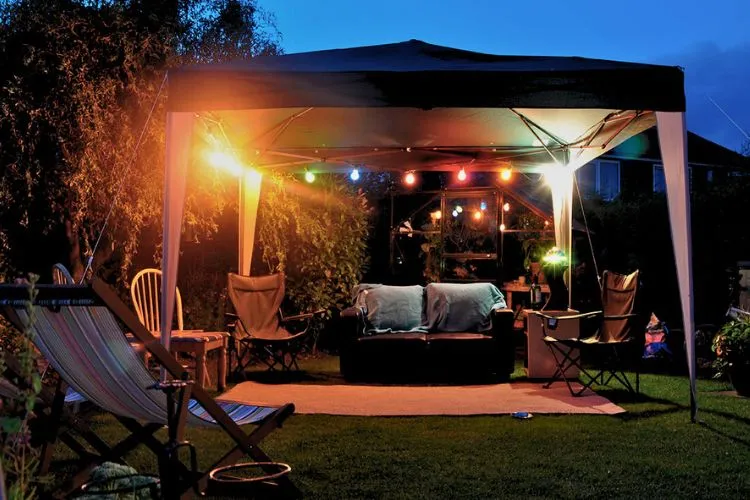
Contents
Why Strengthen Your Pop-Up Gazebo?
The need to strengthen a pop-up gazebo arises from the simple fact that most are not designed to handle severe weather. Heavy rain and strong winds can cause significant damage, leading to costly repairs or replacements.
More importantly, a sturdy gazebo provides a safe environment for guests and belongings. By reinforcing your gazebo, you also enhance its functionality, allowing for worry-free use in various weather conditions.
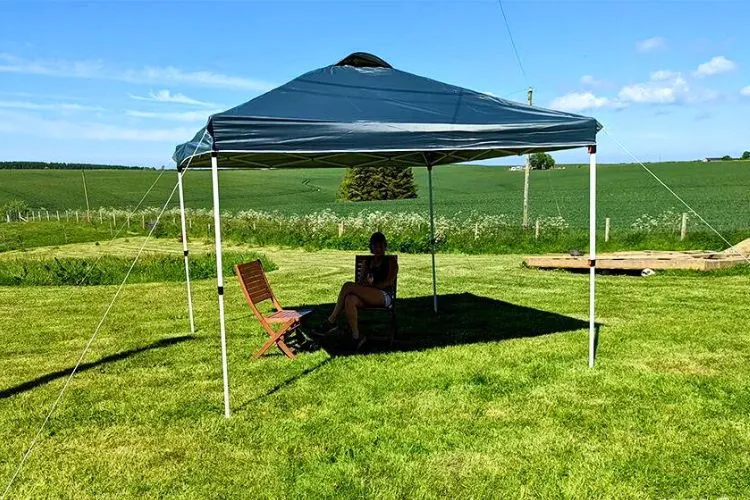
Assessing Your Needs
Before embarking on any modifications, consider the typical weather in your area and your gazebo’s intended use.
A gazebo used for beach outings might require different reinforcements than one used in a backyard. Understanding these factors will guide your choice of strengthening methods.
How To Strengthen A Pop Up Gazebo?
Location Selection
Choosing the right location is the first step in reinforcing your gazebo. If possible, place your gazebo in a sheltered area, away from strong wind paths. Utilizing natural windbreaks, such as walls or thick vegetation, can significantly reduce wind exposure.
Adding Weight and Stability
Securing your gazebo with additional weight is crucial for stability. Sandbags or specially designed weights can anchor the gazebo legs firmly to the ground.
Ensure these weights are fastened securely to prevent any movement that could lead to wear or breakage.
Reinforcing the Frame
The gazebo’s frame is its backbone. Upgrading to a stronger frame material, such as heavy-duty aluminum or steel, can offer enhanced stability.
Regular maintenance checks are also essential to identify and address any signs of wear before they lead to structural failure.
Wind-Resistant Designs and Features
When selecting a gazebo, consider models with wind-resistant features. Aerodynamic designs that allow air to flow through reduce the risk of the gazebo acting like a sail. High-quality materials are less likely to tear under stress, ensuring the gazebo remains functional and safe.
Anchoring Techniques
Proper anchoring is vital, especially in windy conditions. Use stakes and tie-downs to secure the gazebo to the ground. For hard surfaces where stakes cannot be used, heavy-duty anchoring systems designed for such conditions are available.
DIY Tips and Tricks
For those with a knack for do-it-yourself projects, there are creative ways to add stability to your gazebo. Homemade sandbags, using durable bags filled with sand or gravel, can be an economical solution.
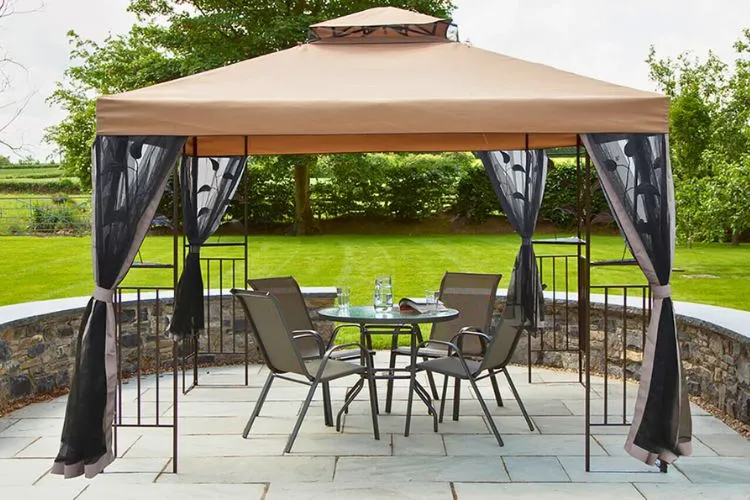
Another trick is to attach PVC pipes filled with concrete to the gazebo legs, adding significant weight at a low cost.
Maintenance and Upkeep
Routine maintenance is key to ensuring your gazebo remains strong and functional. Regular inspections can reveal potential issues, such as loose bolts or tears in the fabric, before they become major problems. Applying weather-proof treatments can also extend the life of the gazebo’s materials.
Weatherproofing Your Gazebo
When it comes to weatherproofing your pop-up gazebo, the choice of fabric for the cover and sidewalls is fundamental. Opt for materials that are specifically designed to handle adverse weather conditions.
Polyester is a common choice – it’s durable, lightweight, and when combined with a PVC coating, becomes water-resistant and offers some UV protection. Canvas, though heavier, is another robust material that offers excellent weather resistance but may require additional treatments for water and mildew resistance.
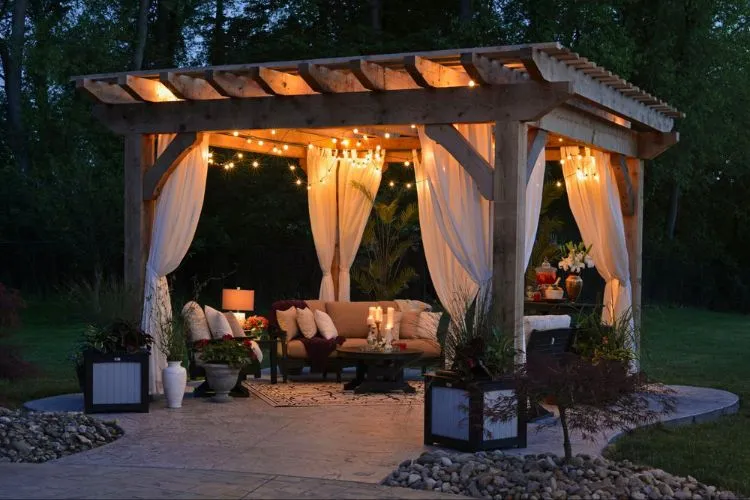
Additionally, consider the denier rating of the fabric – a higher denier indicates a thicker, more durable weave that can better withstand the wear and tear of harsh weather. Some fabrics also come with a vented canopy designed to reduce wind pressure and allow heat to escape, providing both stability and comfort.
To further enhance your gazebo’s weather resistance, applying sealants and coatings is an effective strategy. Waterproofing sprays can be used to seal the seams of the fabric, preventing water from seeping in during rainstorms.
For sun protection, look for UV-resistant sprays that prevent the fabric from degrading or colors from fading due to prolonged sun exposure. Remember to consult the manufacturer’s guidelines to ensure compatibility of such treatments with your specific gazebo fabric.
By selecting the right fabric and utilizing protective treatments, you can significantly enhance your gazebo’s ability to withstand inclement weather, thereby extending its lifespan and ensuring it remains a functional space for outdoor activities, no matter the forecast.
You may also check: How To Decorate A Pop-Up Gazebo in 10 Easy Steps
Safety Considerations
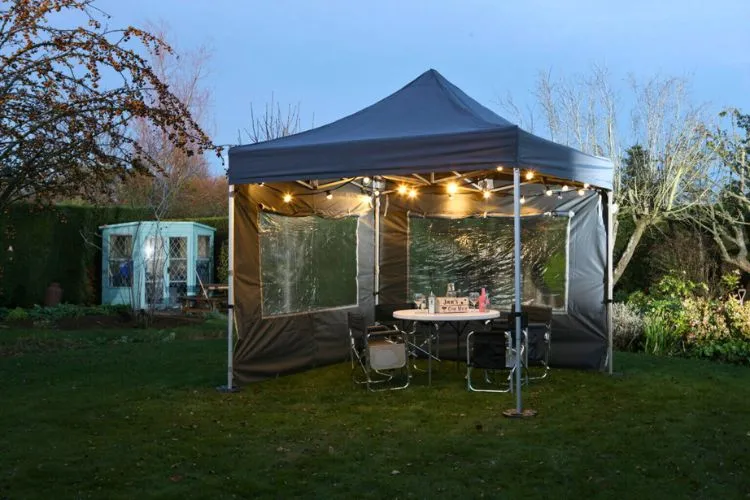
Ensuring Structural Integrity
- Regularly inspect joints and fasteners for signs of weakness or corrosion.
- Check the fabric for tears or degradation which could compromise shelter efficiency.
Emergency Preparedness
- Develop a plan for quickly dismantling or securing the gazebo when sudden severe weather is expected.
- Keep a weatherproof cover handy to protect electronic equipment and furnishings in case of emergencies.
Frequently Asked Questions (FAQs)
How to choose the best location for your pop-up gazebo?
Select a spot that is naturally sheltered from strong winds. Look for flat, stable ground, and consider using natural windbreaks.
What are the most effective weights for securing gazebos?
Sandbags and purpose-made gazebo weights are highly effective. Ensure they are securely attached to the gazebo’s legs.
How often should I check my gazebo for wear and tear?
Inspect your gazebo before and after use, especially if it has been exposed to severe weather. Regular checks will help catch issues early.
Can a pop-up gazebo withstand strong winds?
With proper reinforcements and careful positioning, a pop-up gazebo can be made more resistant to wind. However, in extreme conditions, it is advisable to take it down to avoid damage.
Conclusion:
A well-maintained and properly reinforced pop-up gazebo can provide years of reliable service. By selecting an optimal location, adding weight, upgrading the frame, and utilizing wind-resistant designs, you can significantly increase your gazebo’s stability.
Regular maintenance and creative DIY solutions further contribute to its longevity and safety. With these strategies in place, your gazebo will be better equipped to handle whatever weather comes its way.
By addressing these common questions, users can gain a better understanding of how to enhance their pop-up gazebo’s durability and safety. Facing the elements with confidence starts with a well-prepared and fortified outdoor shelter.

Sergio Gomes, a passionate advocate for outdoor living and the male voice behind Shades Authority. With years of experience, Sergio is your trusted source for expert insights on gazebos, pavilions, cabanas, pergolas, and all things outdoor shade solutions. Join him on a journey to transform your outdoor spaces into stunning, functional retreats
